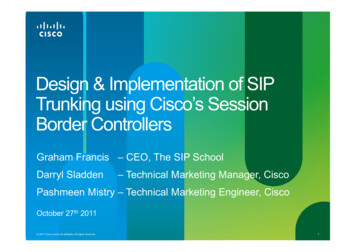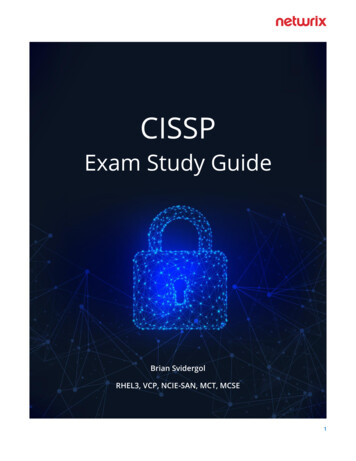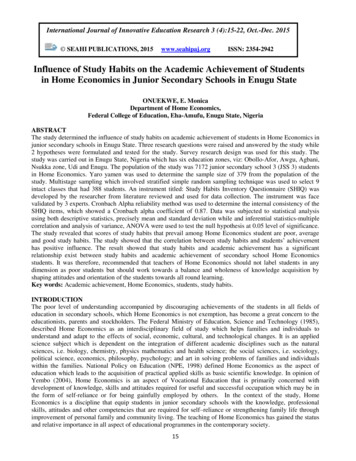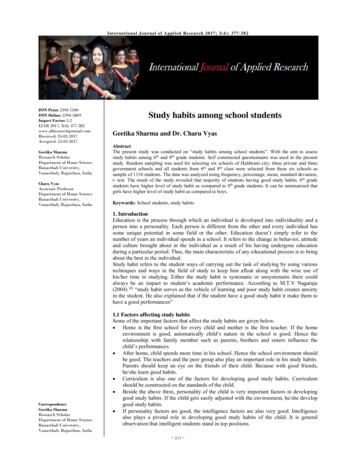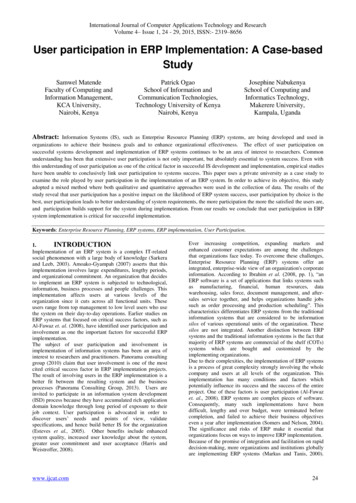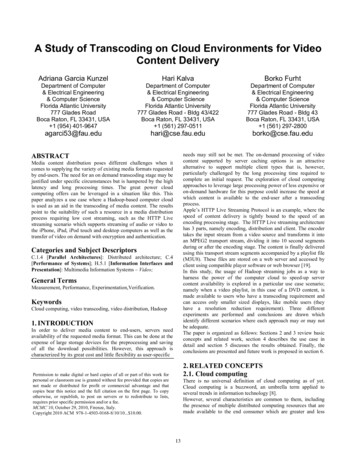
Transcription
A Study of Transcoding on Cloud Environments for VideoContent DeliveryAdriana Garcia KunzelHari KalvaBorko FurhtDepartment of Computer& Electrical Engineering& Computer ScienceFlorida Atlantic University777 Glades RoadBoca Raton, FL 33431, USA 1 (954) 401-9647Department of Computer& Electrical Engineering& Computer ScienceFlorida Atlantic University777 Glades Road - Bldg 43/422Boca Raton, FL 33431, USA 1 (561) 297-0511Department of Computer& Electrical Engineering& Computer ScienceFlorida Atlantic University777 Glades Road - Bldg 43Boca Raton, FL 33431, USA 1 (561) fau.eduneeds may still not be met. The on-demand processing of videocontent supported by server caching options is an attractivealternative to support multiple client types that is, however,particularly challenged by the long processing time required tocomplete an initial request. The exploration of cloud computingapproaches to leverage large processing power of less expensive oron-demand hardware for this purpose could increase the speed atwhich content is available to the end-user after a transcodingprocess.Apple’s HTTP Live Streaming Protocol is an example, where thespeed of content delivery is tightly bound to the speed of anencoding processing stage. The HTTP Live streaming architecturehas 3 parts, namely encoding, distribution and client. The encodertakes the input stream from a video source and transforms it intoan MPEG2 transport stream, dividing it into 10 second segmentsduring or after the encoding stage. The content is finally deliveredusing this transport stream segments accompanied by a playlist file(M3U8). These files are stored on a web server and accessed byclient using compatible player software or web browser [19].In this study, the usage of Hadoop streaming jobs as a way toharness the power of the computer cloud to speed-up servercontent availability is explored in a particular use case scenario;namely when a video playlist, in this case of a DVD content, ismade available to users who have a transcoding requirement andcan access only smaller sized displays, like mobile users (theyhave a resolution reduction requirement). Three differentexperiments are performed and conclusions are drawn whichidentify different scenarios where each approach may or may notbe adequate.The paper is organized as follows: Sections 2 and 3 review basicconcepts and related work, section 4 describes the use case indetail and section 5 discusses the results obtained. Finally, theconclusions are presented and future work is proposed in section 6.ABSTRACTMedia content distribution poses different challenges when itcomes to supplying the variety of existing media formats requestedby end-users. The need for an on demand transcoding stage may bejustified under specific circumstances but is hampered by the highlatency and long processing times. The great power cloudcomputing offers can be leveraged in a situation like this. Thispaper analyzes a use case where a Hadoop-based computer cloudis used as an aid in the transcoding of media content. The resultspoint to the suitability of such a resource in a media distributionprocess requiring low cost streaming, such as the HTTP Livestreaming scenario which supports streaming of audio or video tothe iPhone, iPad, iPod touch and desktop computers as well as thetransfer of video on demand with encryption and authentication.Categories and Subject DescriptorsC.1.4 [Parallel Architectures]: Distributed architecture; C.4[Performance of Systems]; H.5.1 [Information Interfaces andPresentation]: Multimedia Information Systems – Video;General TermsMeasurement, Performance, Experimentation,Verification.KeywordsCloud computing, video transcoding, video distribution, Hadoop1. INTRODUCTIONIn order to deliver media content to end-users, servers needavailability of the requested media format. This can be done at theexpense of large storage devices for the preprocessing and savingof all the download possibilities. However, this approach ischaracterized by its great cost and little flexibility as user-specific2. RELATED CONCEPTS2.1. Cloud computingPermission to make digital or hard copies of all or part of this work forpersonal or classroom use is granted without fee provided that copies arenot made or distributed for profit or commercial advantage and thatcopies bear this notice and the full citation on the first page. To copyotherwise, or republish, to post on servers or to redistribute to lists,requires prior specific permission and/or a fee.MCMC’10, October 29, 2010, Firenze, Italy.Copyright 2010 ACM 978-1-4503-0168-8/10/10. 10.00.There is no universal definition of cloud computing as of yet.Cloud computing is a buzzword, an umbrella term applied toseveral trends in information technology [8].However, several characteristics are common to them, includingthe presence of multiple distributed computing resources that aremade available to the end consumer which are greater and less13
commodity hardware in a reliable, fault-tolerant manner” [3]. Itimplements the MapReduce model suggested by Google in [1] infree distributions like Apache Hadoop, Yahoo Hadoop andCloudera.costly than those provided by a single machine. “Computing in the“cloud” eludes to ubiquitous and inexhaustible on-demand ITresources accessible through the Internet” [8].This availability can be achieved on a service-based type ofinterface where the users can make use of the available resourcesin an on-demand manner, reducing the implementation andmaintenance cost to a single, usage based bill. Fueled by this“utility-computing” concept where computing resources areconsumed the same way as electricity would, huge commercialendeavors like Amazon Web Services were born.In addition, cloud computing has become an integral part of theoperations at Google and Yahoo and Facebook, among others,processing vast amount of data (like search logs for example) in areduced time frame.2.3.1. Hadoop Distributed Filesystem (HDFS).“A distributed file system is designed to hold a large amount ofdata and provide access to this data to many clients distributedacross a network. There are a number of distributed file systemsthat solve this problem in different ways” [4] including HDFS forHadoop’s particular case.HDFS is designed to store a very large amount of information(terabytes or even petabytes) which requires spreading the dataacross a large number of machines. This allows support for muchlarger file sizes than NFS and allows all the processing machinesin the cluster to access a complete and consistent copy of theinformation at hand. However, it requires an extra step to uploadthe data into the distributed file system where it’s stored in theDataNodes as blocks of data. The location of these data blocks ismonitored and managed by a server referred to as the NameNode.2.2. MapReduceLeveraging the power of distributed computing is a challenge thatis taken on by Google with MapReduce.“MapReduce is a programming model and an associatedimplementation for processing and generating large data sets. [InMapReduce] Users specify a map function that processes akey/value pair [of data] to generate a set of intermediate key/valuepairs, and a reduce function that merges all intermediate valuesassociated with the same intermediate key” [1].MapReduce’s value lies in the possibility of automaticparallelization of activities and their distributed execution thanksto the independence existing between all mapper and reducer tasksstarted. However, this implies that the problem to be solvedthrough MapReduce needs to be expressible in its specific model.Common tasks that conform to it are log analysis, like web searchhistory analysis where searches may be mapped to IPs, sorted bytimes and topics, among others. As a result, eventually they maybe related to other user’s similar searches and smart suggestionsmay be given to user while browsing.In MapReduce, the run-time system takes care of the details ofpartitioning the large input data, scheduling the program'sexecution across the machines and handling hardware failures.This allows developers to concentrate on the task at hand, whichmay be simple (although involving large amounts of data) andforget about underlying machine issues.2.3.2. Hadoop StreamingHadoop is based on Linux environments and suggests Java for theprogramming of the mapper and reducer. However, Hadoopprovides an API to MapReduce that allows writing the map andreduce functions in languages other than Java: Hadoop Streaminguses Unix standard streams as the interface between Hadoop andan external program, so any language that can read standard inputand write to standard output can be used to write the MapReduceprogram [7]. This can be particularly useful when making use ofalready existing tools that are to be included in the mapping orreducing stages.Note that the concept of Hadoop streaming is not in any wayrelated to the concept of video streaming.3. RELATED WORKSolutions such as x264farm approached encoding in a distributedenvironment as early as 2006 [18]. X264farm utilizes x264, a freeh264/avc encoder [17], to accomplish encoding into the H.264format. Not unlike Hadoop, the x264farm system consists of acontroller machine that gives commands and data to a set of agentmachines that run x264 to perform the encoding.More in detail, the controller carries out several passes to completethe procedure. The first pass consists of a splitter stage where theunencoded source video is divided into ranges and runssimultaneously with a worker stage. The worker stage picks outranges from the splitter and streams the raw video data of the rangeout to the agents. The workers receive the stats file produced bythe agents and process it. After the first pass ends, the controllerreads the agents’ stat files and breaks it into groups of pictures(GOPs) each starting with an “I” frame. A rate control equationfigures out the optimal bitrate for every GOP which is then sent tothe agents for encoding. This process is repeated for several morepasses. How close the actual bits produced are to the optimal bitscalculated ensures a more accurate GOP that requires less reencoding passes [18].This is the basis of the system’s controller based encodingapproach, where only the controller has access to the input video.However, agent based encoding is also supported wherecontroller’s AVS file is available to all agents and no streamingFigure 1. The MapReduce pipeline [5]2.3. Hadoop“Hadoop Map/Reduce is a software framework for easily writingapplications which process vast amounts of data (multi-terabytedata-sets) in-parallel on large clusters (thousands of nodes) of14
guarantees good video quality and higher priority duringinformation package distribution when resources are low.over the network is required. This AVS file is used as input tox264, but if for some reason it cannot be found, the controllerbased approach is preferred [18].The power of this solution is restricted by its limited formatsupport. This translates into a limited problem area that requiresH.264 specifically and encoding only approaches (no transcodingoption). In addition, the requirement of raw video datatransmission over the network is certainly a drawback that can loadthe network heavily.The published implementation of media processing on cloudenvironments particularly has been focused specially on imageprocessing, not video: Specifically, [11] and [10] discuss anexample and an implementation respectively, of image processingtasks on cloud environments.In [9], this processing is actually achieved through a MapReduceimplementation which estimates geographic information (where isthe scene?) given a specific image, by leveraging a data set ofaround 6 million GPS-tagged images and using scene matching tofind the most similar image through a reduce-less program.In the same manner, [12] implements on MapReduce a set of threeexperiments in image processing, namely a Simple Pixel Detectiontest, a Blob Detection test and a Sobel Edge Detection test.One of the major examples of image processing/transformation oncloud environments is the New York Times archive conversion,where the TIFF images of the public domain scanned articles from1851 to 1922 were converted to PDF format [13]: Around 11million articles were converted and glued together in under 24hours processing using around 100 nodes of Amazon WebServices’ EC2 instances using the MapReduce model.As far as video processing goes, fewer examples are available, oneof them being HP Labs’ VideoToon implementation [14], where aservice is implemented to “cartoonize” videos with the help ofHadoop streaming.Commercially, video transcoding on cloud environments isavailable through HDCloud.com and Encoding.com, whichprovide a flexible but proprietary cloud based video transcodingservice integrated with Amazon Web Services's EC2, S3, andCloudFront CDN services.On the other hand, an option for the distribution of video with thehelp of cloud environments is explored by Fouquet et.al [15].Fouquet presents a way of making cloud-based infrastructuredirectly useful for end-users by integrating it into peer-to-peersystems and exemplifies it through an application that makes useof the cloud without requiring a business relationship between thesoftware vendor and the cloud operator. In that application the firstpeer, the sender, has a live video stream that several clients want toview. The application that distributes the video is an open sourceP2P streaming system that can work with multiple cloud serviceproviders or on a pure P2P basis. When a user is willing to pay asmall amount of money to be able to view a stream and serve as arelay server, improving video quality for him/her as well as otherviewers, the application spawns virtual machine images on thecloud on behalf of the user, having him assume the cloud chargesthat come with it. The peer-to-peer distribution tree is then updatedwith the new server.An application as the one described above uses a payment modelwhich is uncommon on today's Internet: Some users pay moneyand sponsor the service for the others. It is unclear whether itsmodel will be understood and supported by the end-customersalthough users who sponsor a cloud server could gain certainadvantages such as a privileged position in the distribution that4. USE CASEFor the purpose of exploring the advantages/disadvantages ofimplementing cloud computing concepts in the transcoding stageof the video content delivery the process the following use casewas explored:A text file representing a video playlist made from a DVD’scontent is processed under three different experiments conceivedunder the light of the cloud storage challenge of node dataaccessibility: Experiment 1 (E1): when the playlist content (the transcodinginput) is available preloaded on HDFS and the transcodingoutput is loaded there as well, generating the necessity of anadditional final transfer to the actual web server that is nottaken into account in the results (HDFS to HDFS).Experiment 2 (E2): When the playlist content is preloaded onHDFS and the transcoding output is stored on an externalstorage accessible from all cloud processing nodes andpotentially the web server (HDFS to Common External orCE).Experiment 3 (E3): When the playlist content is available onan external storage accessible from all cloud processing nodesand potentially the web server and the transcoding output isavailable there as well (CE to CE).Variations of these experiments are explored as well, where theDVD content is split into chapters (context segmentation), into 10ssegments (consistent with HTTP Live streaming recommendation[19]) and a number of pieces equal to the number of processingnodes available (to explore speed-up thanks to distributedprocessing).These experiments were run as Hadoop streaming jobs usingffmpeg [20] as a transcoding tool with only a mapping stage. Theuse of ffmpeg potentially enables the use of all the formats andtranscoding options supported by it.In HTTP Live streaming, the segmented short media files areplaced on the web server where the client software requests themin the order specified by a published index and displays themwithout any pauses or gaps between them [19]. Hence, theimplementation of a Hadoop reducing stage was deemedunnecessary as the resulting output information and videosegments didn’t require to be re-combined in a single output andtranscoding could be completely achieved in a single stage.The hardware on which the tests were run was a 3 node clusterwith 2047MiB System memory and two 3.8GHz Intel Xeonprocessors each; all connected to an external SCSI storage.This setup should help in the evaluation of a Hadoop-based systemthat can later be migrated to a low cost unlimited-node publiccloud environment such as Amazon. An Amazon based solutioncould potentially scale-up and support a massive amount of clientswith little resource investment.5. RESULT EVALUATIONThe results for each of the three experiments proposed arepresented next for analysis.15
5.1. Approach comparisonFrom the experiments, the performance of each of the transcodingsource/destination approaches is evaluated.The total procedure time results (time for the total content to beavailable including transfer time) can be viewed in Figure 2 forcontent of a DVD’s chapter 20:18 minutes long split in 10 secondsegments.Figure 4. Source/destination combination performancecomparison: Transmission timeThe time drawback of approach 1 is exacerbated by an additionaltime required for data movement to a web server location, which isnot taken into account in the experiment. Counterbalanced by this,is the less strict machine storage requirements, as the transcodingresult storage load is shared among all cluster nodes. This pointsto an approach that’s more appropriate for offline transcodingwhere no time constraints are present.Figure 2. Source/destination combination performancecomparison for transcodingThe best results are achieved by experiment number 3, where thetotal procedure time is minimum. Since the data and encodingparamenters are the same on all experiments, actual processingtime is similar in all of them (Figure 3). The main difference liesin the transmission time for HDFS: Note that the experiments aredone through the Hadoop Streaming option, hence the transmissionto a location where the streaming program can access the data isrequired.5.2. Availability comparisonNext, the availability of the content was studied.Once the content is requested, a delay between the request and theavailability of an output due to the encoding process is expected.Keeping this delay to a minimum is clearly desirable as it impactsthe user’s experience directly. This transcoding delay wasanalyzed under 3 different variations for all three experiments: Having the content split into the same number of piecesas there are nodes available for processingHaving the content split by context (in DVD chapters)Having the content split into 10s segmentsAs already established in the previous section, experiment 3 (CE toCE), yields better results, conclusion which is consistent with theoutcome for these variations. Hence, only the results forexperiment 3 are presented next.The three figures presented next show the time required in thesystem for the production of an encoded output (availability), as afunction of the start time of the respective content split duringnormal playback. The minimum requirement is that the content isavailable at least at playback time in order to enable its displaywithout gaps. This is represented by the Minimum AvailabilityRequirement curve. In an ideal environment, the producedavailability curve never crosses the minimum curve. In reality, thebest case scenario will minimize this effect, particularly at thebeginning of the encoding process where the user is impacteddirectly by a waiting period.Figure 3. Source/destination combination performancecomparison: Processing timeExperiment number 1 requires the transmission of the data twice,once out of HDFS and once transcoded, back into it. Experimentnumber 2 requires only one transmission, to a location where thefile is processed and or/shared with the web server. On Experiment3 data is only transcoded through the Hadoop job, locations arenever changed.Trick modes such as rewinding and forwarding in the video are notstudied here as solutions such as HTTP Live streaming don’t focuson them.16
From the Figure 5 to Figure 7 it can be observed that theavailability time is reduced when the content is split equallyamong the number of nodes available for processing, but at theexpense of a longer starting delay.Splitting the content by context makes processing moreunpredictable and the starting delay time will be directly related tothe first split’s encoding delay.The preferred performance is achieved with the 10s segment split:The starting delay is low and the throughput uniform over time.The serrated effect on the availability curve is due to a slightlyfaster output for splits belonging to a later time frame consequenceof the split distribution among the nodes.Startup delay5.3. Additional observationsDuring experiments it was noticed that a better results can beachieved by direct manipulation of the playlist; the input list canbe sorted and split among the nodes according to playback orderand file size achieving lower total procedure completion time.Notice Figure 8 where the 10s segment playlist (the list has similarsized items all over) is divided in several different Hadoop jobinput files. This split can assure better balancing among the nodesand ensure the participation of them all.Figure 5. Availability time for a DVD chapter (20m 18s long)split in 3 equal parts. First segment delay: 2m 32s.Figure 6. Availability time for all the segments in the DVD(2h 18min long). First segment delay: 2m 12s.Note: Segments by context have different durations.Figure 8. Balanced vs. unbalanced experiments. 10s segmentsfor a 20m 18s video.Figure 9. Balanced vs. unbalanced experiments for DVDchapters.Figure 7. Availability time for a DVD chapter (20m 18s long)split in 124 10s segments. First segment delay: 10s.The balancing of the splits by context (by sorting, arranging bysize and dividing the load equally among the nodes) reduces thetotal procedure time significantly as shown in Figure 9.17
Research Pittsburgh, May (2008) Online at:http://www.google.com/url?sa t&source web&cd 1&ved 0CBYQFjAA&url http%3A%2F%2Fwww.pittsburgh.intelresearch.net%2F chensm%2Fpapers%2FIRP-TR-0805.pdf&ei YXASTIHvGMKclgfk593DBg&usg AFQjCNGwpE z9dc4qJ7Lr1faSni7ylL1ZQThis reduction is particularly significant for this case, where thefirst chapters of the DVD pose a bigger load than the latter onesand they should be properly divided among the nodes.6. CONCLUSIONSMapReduce as a distributed computing technique has gainedimportance and has become key system in noteworthy commercialendeavors (Google, Yahoo, NetFlix, etc.) As discussed in therelated work section the extension of this text-oriented techniqueto other areas like media processing has already begun. Itscontribution in media distribution is only starting but could besignificant: The processing power of a Hadoop cluster can greatlyimprove encoding times and free the web server’s resources fromunrelated tasks.As further work is performed, the load in number of HTTP Livestreaming users remains to be tested with this particular hardwareconfiguration and approach. In the mean time, the results of thisstudy point to interesting possibilities as far as low cost video anddistribution goes which can be particularly benefit mobile deviceusers.[10] D. Chantry, "Mapping applications to the Cloud” MicrosoftCorporation—Platform Architecture Team, January (2009)Online at: px[11] H. Trease, D. Fraser, R. Farber, S. Elbert, "Using TransactionBased Parallel Computing to Solve Image Processing andComputational Physics Problems" Online ase.pdf[12] J. Conner, "Customizing Input File Formats for ImageProcessing in Hadoop", Arizona State University. July (2009)Online at: http://hpc.asu.edu/node/97[13] New York Times, "Self-service, Prorated Super ComputingFun!" November 1, (2007) Online erviceprorated-super-computing-fun/7. REFERENCES[1] J. Dean and S. Ghemawat, “MapReduce: Simplified DataProcessing on Large Clusters,” in Proceedings of OSDI ’04:6th Symposium on Operating System Design andImplemention, San Francisco, CA, Dec. 2004. Online ] HP Labs, "VideoToon" Online at:http://www.hpl.hp.com/open innovation/cloud collaboration/cloud demo transcript.html[15] M. Fouquet, H. Niedermayer, G. CarleCloud, "Computing forthe Masses" Technische Universität München, Proceedings ofthe 1st ACM workshop on User-provided networking:challenges and opportunities, Rome, Italy (2009), p.31-36Online at:http://portal.acm.org/citation.cfm?id 1659029.1659038[2] "Apache Hadoop" Online at:http://hadoop.apache.org/#What Is Hadoop%3F[3] "Map/Reduce Tutorial" Online pred tutorial.html[16] K. Asanovic, R. Bodik, B. Catanzaro, et al., “The landscapeof parallel computing research: a view from Berkeley”,Technical Report UCB/EECS-2006-183, EECS Department,University of California, Berkeley, December (2006). Onlineat: CS2006-183.pdf[4] "Hadoop HDFS" Online fs user guide.html[5] "Yahoo Hadoop Tutorial" Online le4.html[17] VideoLan, "x264 - a free h264/avc encoder" Online at:http://www.videolan.org/developers/x264.html[6] "Yahoo HDFS Tutorial" Online le2.html[18] R. Wilson, "x264farm. A distributed video encoder" (2006)Online at: http://omion.dyndns.org/x264farm/x264farm.html[7] T. White, “Hadoop: The Definitive Guide”, O’Reilly, FirstEdition. June (2009) ISBN: 978-0-596-52197-4[19] iOS Reference Library, "HTTP Live Streaming-Overview"Online diaguide/introduction/introduction.html[8] D. Hilley, "Cloud Computing: A Taxonomy of Platform andInfrastructure-level Offerings", Georgia Institute ofTechnology, April (2009) Online /git-cercs-0913.pdf[20] ffmpeg, “FFMPEG”.Online at: http://www.ffmpeg.org/[9] S. Chen, S. W. Schlosser. Map-Reduce Meets Wider Varietiesof Applications, IRP-TR-08-05, Technical Report, Intel18
endeavors like Amazon Web Services were born. In addition, cloud computing has become an integral part of the operations at Google and Yahoo and Facebook, among others, processing vast amount of data (like search logs for example) in a reduced time frame. 2.2. MapReduce Leveragi
